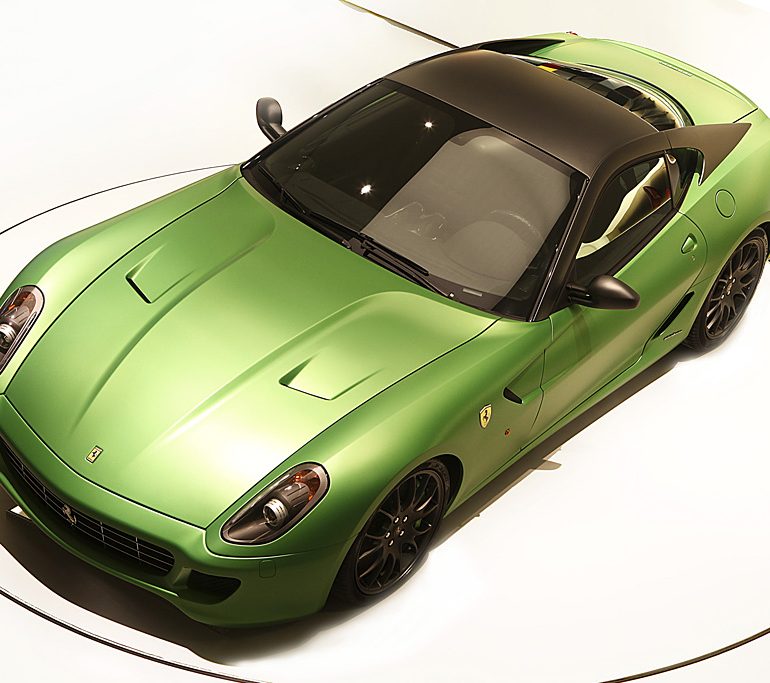2010 Ferrari 599 HY-KERS vettura laboratorio
Geneva, March 2nd 2010 – The HY-KERS vettura laboratorio (experimental vehicle) is an example of how Ferrari is approaching the development of hybrid technology without losing sight of the performance traits and driving involvement that have always exemplified its cars.
This hybrid project is also aimed at ensuring that Ferrari will be in a position to comply with future CO2 emissions standards, particularly in terms of the urban cycle. City driving is traditionally where sports cars are most penalised as their engines are designed for maximum efficiency and performance at high revs, whereas the urban cycle involves low revs and low engine loads.
Ferrari has employed its racing experience to adapt an advanced, lightweight hybrid drivetrain to the 599 GTB Fiorano with the aim of ensuring that vehicle dynamics are unaffected. This was achieved by the careful integration of all system components, positioning them below the centre of gravity and ensuring that interior and luggage space are entirely unaffected. Similarly the flat lithium-ion batteries are positioned below the floorpan. The result is a centre of gravity that is even lower than in the standard car.
Ferrari has also applied its F1 technology to the design, engineering and construction of a new kind of electric motor which helps optimise the longitudinal and lateral dynamics of the car, enhancing traction and brake balance. The motor also features a unique cooling and lubrication system for maximum efficiency under all operating temperatures and loads.
Weighing about 40 kg, the compact, tri-phase, high-voltage electric motor of the HY-KERS is coupled to the rear of the dual-clutch 7-speed F1 transmission. It operates through one of the transmission’s two clutches and engages one of the two gearbox primary shafts. Thus power is coupled seamlessly and instantaneously between the electric motor and the V12. The electric motor produces more than 100 hp as Ferrari’s goal was to offset every kilogram increase in weight by a gain of at least one hp.
Under braking the electric drive unit acts as a generator, using the kinetic energy from the negative torque generated to recharge the batteries. This phase is controlled by a dedicated electronics module which was developed applying experience gained in F1 and, as well as managing the power supply and recharging the batteries, the module also powers the engine’s ancillaries (power steering, power-assisted brakes, air conditioning, on-board systems) via a generator mounted on the V12 engine when running 100 per cent under electric drive. It also incorporates the hybrid system’s cooling pump.
This experimental vehicle thus maintains the high-performance characteristics typical of all Ferraris while, at the same time, reducing CO2 emissions on the ECE + EUDC combined cycle by 35 per cent.
Ferrari California Stop&Start
The other important novelty at the Geneva Show is again aimed at reducing emissions. From March 2010 in fact the Stop & Start system will be available on the Ferrari California, reducing fuel consumption and CO2 emissions by 6 per cent in the ECE + EUDC combined cycle. This means a figure of 280 g/km, one of the most competitive of any high-performance cars. The Stop & Start cuts in virtually instantaneously – just 230 milliseconds, a time so fast that the driver barely notices the engine restarting.
This solution is a further step in Ferrari’s on-going strategy to reduce fuel consumption and emissions, even when increasing performance. One of the principal areas of research has been dedicated to reducing friction within the engine. The Ferrari California’s direct-injection V8, for example, has eliminated the ‘pumping’ losses created by the changes in pressure below the pistons. Inserting purge valves in the crankcase below the crank throws allows blow-by gas and oil compressed during the combustion phase to leave the crankcase without being drawn back in during the compression phase. This ensures a direct increase in engine efficiency.
In addition DLC (Diamond Like Carbon) coatings on the valve followers and super-finishing of the cam lobes reduces friction in the valve train and contributes to the overall improvement in engine friction.
Self-sufficient with green power in Maranello
In keeping with Ferrari’s 360-degree approach to efficiency and its commitment to environmental sustainability, new technologies for its road cars are matched by the considerable investments already made to reduce the environmental impact of the company’s production activities in Maranello.
After the inauguration of the photovoltaic installation on the roof of the Mechanical Machining facility in January 2009, which reduced the factory’s power requirements by over 210,000 kWh annually, 2009 also saw the opening of Italy’s biggest trigeneration plant (the simultaneous production of power, heat and cooling from a single source) – the first of its kind to be implemented by a sports car manufacturer. Combined, the two systems reduce CO2 emissions by 30,000 tons a year (40 per cent). Thanks to these ecological solutions, Ferrari is completely autonomous for its energy requirements. This reduction also means that Ferrari will meet the Kyoto protocol objectives a full 10 years ahead of schedule and with double the figure imposed on Europe.
This represents another significant step forward in the ‘Formula Uomo’ strategy implemented by Ferrari’s Chairman, Luca di Montezemolo, at the end of the 1990s and which has transformed the Maranello production facility into one of the most advanced in the world. It has also helped create a unique working environment which, in addition to other initiatives for the well-being of employees, ensures that Ferrari has become a model, as demonstrated by the fact that the factory has, in the past, received the ‘Best Place to Work in Europe’ award.
2010 Ferrari 599 HY-KERS vettura laboratorio Gallery
See full 2010 Ferrari 599 HY-KERS vettura laboratorio Gallery here
In Detail
| type | Concept / Prototype Car |






